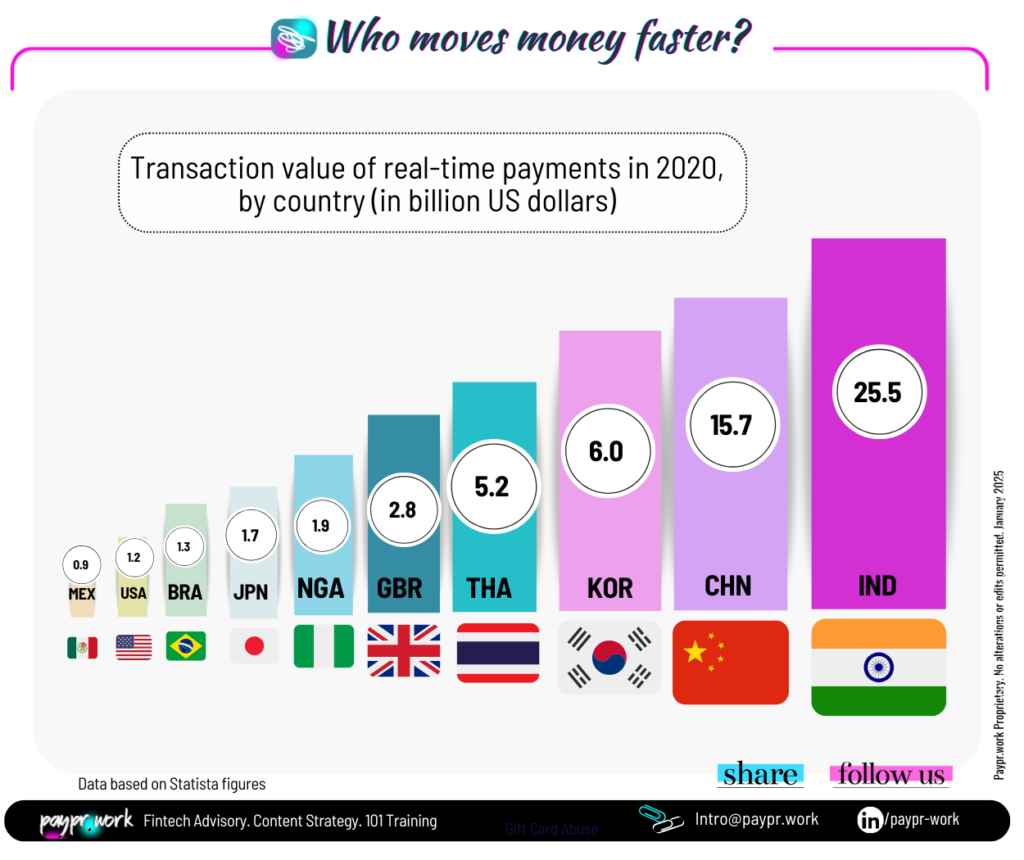
While cash and checks have been steadily declining in favour of digital payment methods, the variety of payment rails still offers widely varying processing times. Traditionally, bank transfers have lagged behind in terms of speed and efficiency, often taking days to settle.
However, this landscape is changing rapidly. Countries across the globe are modernising their banking infrastructure to facilitate faster, more secure money movement.
Real-Time Payments (RTP) refer to digital payment systems that enable the instantaneous transfer of funds between parties, typically settling the transaction within seconds. Unlike traditional payment methods, such as bank transfers or credit card payments, which can take hours or even days to process, RTP provides immediate confirmation and access to funds. This efficiency has made RTP a transformative force in the global payments ecosystem.
RTP systems are designed to operate 24/7, providing uninterrupted service and allowing payments to be initiated and completed at any time, including weekends and holidays. This capability makes RTP highly advantageous for businesses, governments, and individuals by offering unmatched speed, convenience, and reliability.
RTP systems cater to a wide range of payment scenarios, such as:
In Europe, as of January 9, 2025, the SEPA Instant Credit Transfer (SCT Inst) mandate is officially in effect, marking a significant milestone in Europe’s payments landscape. SEPA, the Single Euro Payments Area, is a unified payment network enabling euro-denominated transfers across 36 countries.
With the deadline now passed, all banks in euro area Member States are required to support instant payments as a standard service. This ensures that the foundational infrastructure for real-time payments is now fully operational across the eurozone.
Global Leaders in Real-Time Payments

Countries like Brazil, Nigeria, and Japan are also showing accelerated growth in RTP adoption, with transaction volumes steadily increasing. Brazil’s Pix system, launched in 2020, is rapidly gaining traction and transforming how payments are processed in the region.
The rise of RTP offers numerous benefits:
While real-time payments and faster payments are often used interchangeably, they are not the same.
In other words, all real-time payments are a form of faster payments, but not all faster payments are real-time.
The global RTP market is projected to grow exponentially. By 2027, it is estimated that RTP transactions will exceed 511 billion, accounting for a significant share of all electronic payments. Governments, fintech companies, and traditional banks are all investing heavily to expand the reach and capabilities of RTP systems.
Paypr.work blends payment knowledge and custom research into a simplified yet insightful narration. Our narratives feature visually engaging designs that break down both fundamental and complex payment jargons into bite-sized, repetitive micro-concepts to promote better comprehension and retention.
Sign up for a Paypr.work Premium Membership to exclusively access all of our payment resources, including our full articles, industry insights, ecosystem maps, reports, videos, and our unique library of bespoke infographics.
Don’t miss out— sign up to learn payments in a captivating way!



You have provided so much light and knowledge in a fascinating world. You definitely bring the fun to Fintech like no one else and actually know what you are talking about! Thanks goodness for you😁!

Vice President Global Product Expansion, Shift4
Impressive, congratulations Sandra and Team Paypr.work. The detail in each of your 100+ infographics is outstanding and showcases your expertise well… Continued success for this remarkable work!

LinkedIn Strategist | Digital Transformation Leader

Host of Heads Talk
Your diagrams have the ability to explain the most complicated of topics in way that can be understood by anyone. Not many people have the ability to create self-explanatory visuals, so keep doing your magic 🔥🔥🔥!

CEO & Co Founder of CLOWD9
Your content is so informative, accurate, and fabulously presented in infographics that always attract great attention. Your visuals naturally spark strong engagement regardless of the LinkedIn algorithms !

B2B Marketing, Marqeta
The depth of Paypr.work knowledge and skill sets are truly impressive. Their ability to combine deep industry expertise with well-depicted visual is pretty unique. I strongly recommend Sandra and Paypr.work !

Director EMEA Payment Solutions, Marriott International
👏👏 👏👏 👏👏 I always love your content and in fact, I am so happy for all of us in the industry… we’re lucky to have you sharing your payment wisdom with us 🤓… thank you! Keep up the great work.

Strategic Accounts Director, Truelayer | Payments and Fintech Geek
Merci Sandra pour ta facilité à vulgariser le paiement via de simples dessins, qui me surprendront toujours. Pour ceux qui ne connaissent pas son travail, je vous invite à suivre Paypr.work [ˈpeɪpəwəːk]!

Product Manager Paiement, Maisons du Monde
Your enthusiasm and ability to simplify Payments is so refreshing and literally shines through! Sandra and her team research, write content and create some stunning infographics for the payments industry….

Chief Operations Officer, Clowd9
Keep up the good work and know that your hard work and dedication is so inspiring for all of us. You are truly doing an incredible job and your consistent efforts don’t go unnoticed.

Chief Community Officer, NORBr | Redefining Payment Infrastructure | Linkedin Top Voice
Your posts are a masterclass in how payments have evolved from a basic utility to a strategic asset. Your ability to simplify this complexity and provide strategic direction along with implementation support is so invaluable. The clarity and depth you provide are exactly what this fast-evolving industry needs.

Chief Commercial and Operations Officer, Soffid
The mechanics of all things payment are a black box for most industry stakeholders. With the help of their well researched and designed infographics, Sandra and her team at Papr.work demystify complex flows and create awareness about the factors that play a role in the end to end processes.

Paul van Alfen | Managing Director Managing, Up in the Air - Travel Payment Consultancy
Your Paypr.work subscription gets you full access to all Paypr.work content in 1 place including: our weekly new payments articles, our infographic blog, exclusive discounts on all the services that Paypr.work has to offer and the opportunity to collaborate on free infographic to promote your knowledge/value proposition and more. The content is for personal use and cannot be copied, reproduced, redistributed, altered, modified, shared publicly or with third-party nor can derivatives of the work be created. The user may share content that is available through the free blog access subject to crediting Paypr.work with the attributions.